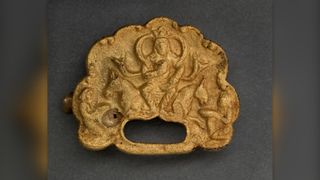Description

Disclaimer: Copyright infringement not intended.
Context
The discovery of two gold ornaments in a 1,500-year-old tomb in Kazakhstan has unveiled the earliest known depictions of a Göktürk "khagan," shedding light on the ancient history and cultural significance of the Turkic-speaking Göktürk people who thrived in the region for around three centuries.
Details
Archaeological Findings
- Location: The discovery was made at the Eleke Sazy site near Kazakhstan's eastern borders with China, Mongolia, and Russian Siberia.
- Artifacts: The two gold plaques found in the tomb depict a Göktürk khagan seated on a throne flanked by kneeling servants. These plaques, likely belt buckles, are believed to symbolize the power and status of the wearer.
- Depiction: The khagan is portrayed wearing a crown, seated on a throne representing two horses, showcasing a regal and sacred representation of power in ancient Turkic society.
- Historical Context: The tomb, believed to hold the remains of a nobleman or "tegin" from the sixth century, evolved into a cultic memorial complex by the seventh century, emphasizing the deification of the deceased individual.
Significance and Interpretation
- Symbol of Power: The artifacts, especially the gold plaques, are considered symbols of high status and likely held significance in Göktürk society, possibly worn by individuals of considerable authority.
- Ashina Clan: It's suggested that the depicted khagan belonged to the ruling Ashina clan, known for founding Turkic states in the Eurasian Steppes from the 5th to 8th centuries.
- Cultural Complexity: The temple complex at Eleke Sazy served as a significant cultural and spiritual center, indicating the Göktürk's ideological, religious, and philosophical orientations. It represents the entry of ancient Turks into historical narratives.

Additional Artifacts and Site Details
- Artifacts Found: Aside from the gold plaques, numerous other items were discovered at the Eleke Sazy site, including weapons, gold, silver, iron, and bronze objects, equipment for horses, and a rock crystal amulet.
- Site Structure: The temple complex comprised two main parts enclosed by courtyard walls, featuring a central burial chamber and a labyrinth for visiting pilgrims. The labyrinth possibly served as a religious space for worship and veneration.
About Göktürks
- The Göktürks were a prominent Central Asian nomadic confederation that played a significant role in the history and shaping of the Eurasian steppes from the 6th to 8th centuries.
- They were a Turkic people who established a powerful and enduring khaganate in the region, exerting influence over vast territories and contributing to the political, cultural, and military landscape of their time.
Origins and Early History:
- Nomadic Origins: The Göktürks were of Turkic descent and emerged as a confederation of Turkic tribes in the Central Asian steppes.
- Establishment of the Khaganate: They were initially part of the Eastern Turkic Khaganate until internal conflicts led to the split and subsequent formation of the Western Turkic Khaganate around 552 CE.
- Leadership and Structure: The Göktürks were led by khagans (emperors) who held authority over a confederation of tribes. They maintained a hierarchical structure with distinct military, administrative, and societal roles.
Expansion and Hegemony:
- Territorial Expansion: The Göktürk Khaganate expanded its influence across a vast expanse, including parts of Central Asia, Mongolia, and even reaching into parts of China and the Middle East.
- Diplomatic Relations: They were actively involved in diplomatic relations with neighboring empires such as the Byzantine Empire, Sassanian Persia, and Tang China.
- Military Prowess: The Göktürks were known for their military strength, utilizing cavalry and archery, which made them formidable opponents and facilitated their territorial expansions
Socio-Cultural Contributions:
- Turkic Language and Writing: The Göktürks played a crucial role in the development of the Old Turkic language and runic script, which was used for inscriptions and official documents.
- Cultural Exchange: They were instrumental in the transmission of cultural, technological, and religious ideas across Eurasia due to their interactions with various civilizations along their trade routes.
Decline and Legacy:
- Internal Struggles: Internal power struggles and conflicts between different factions within the Göktürk Khaganate weakened its unity and led to its eventual fragmentation.
- Fragmentation and Successors: After the collapse of the Khaganate in the mid-8th century, various successor states emerged, continuing to play a role in the region's history.
- Legacy: Despite their eventual decline, the Göktürks left a lasting legacy in Central Asian history, contributing significantly to the Turkification of the region and influencing subsequent Turkic empires.

Conclusion
This discovery offers invaluable insights into the Göktürk civilization, emphasizing their cultural, religious, and symbolic practices, shedding light on their social hierarchy, and showcasing their rich heritage and contributions to ancient Central Asian history.
|
PRACTICE QUESTION
Q. The Göktürks were known for their significant contribution to which of the following aspects?
A) Maritime trade
B) Architectural advancements
C) Development of the Old Turkic language and runic script
D) Industrial revolution
Answer: C)
|







